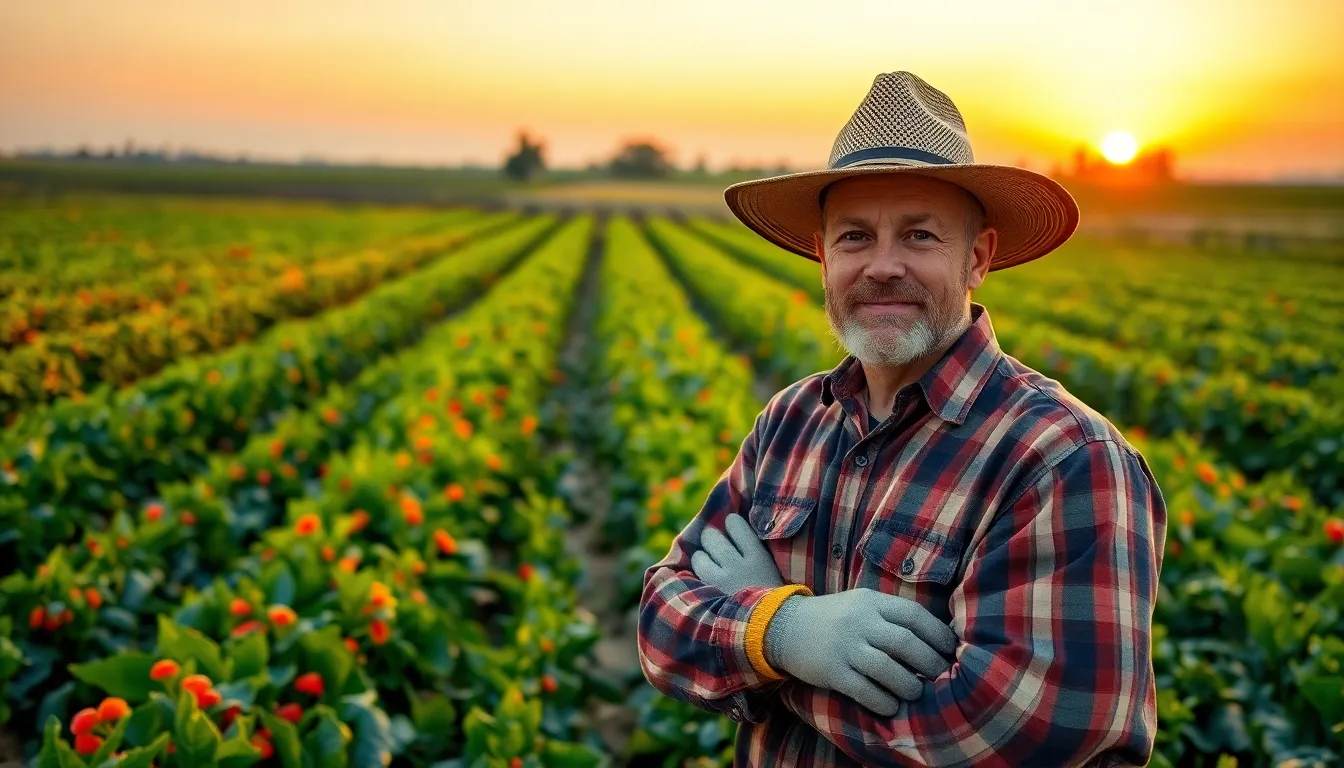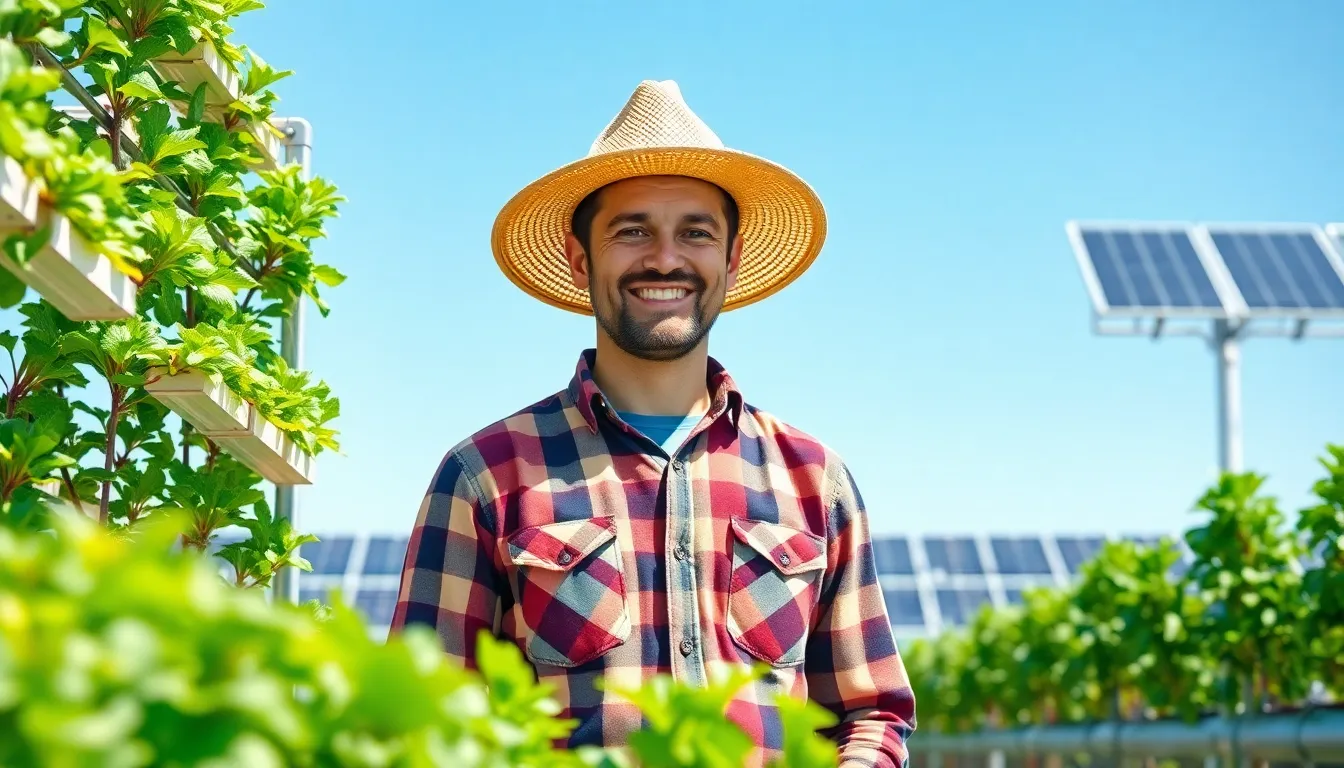In a world where the phrase “going green” is as popular as avocado toast, sustainable farming technology is stepping into the spotlight. Imagine a farm where robots do the heavy lifting while farmers sip their organic lattes, all while Mother Nature gives a satisfied nod. This isn’t just a dream; it’s the future of agriculture, blending innovation with eco-friendly practices to keep our planet happy.
As climate change looms and resources dwindle, farmers are turning to cutting-edge technologies that not only boost productivity but also protect the environment. From precision agriculture to vertical farming, these advancements are transforming the way food is grown. So buckle up, because sustainable farming technology is about to take you on a wild ride through fields of innovation, where saving the planet is as easy as pie (or should we say, a slice of organic, gluten-free pie?).
Table of Contents
ToggleOverview Of Sustainable Farming Technology
Sustainable farming technology focuses on practices that enhance agricultural productivity while minimizing environmental impact. Several key innovations contribute to this transformation, including robotics, precision agriculture, and vertical farming. Robotics automates tasks, reducing labor costs and improving efficiency.
Precision agriculture employs data analytics to optimize resource use, ensuring crops receive the right amount of water and nutrients. Real-time monitoring through sensors helps farmers make informed decisions, resulting in higher yields and less waste. Vertical farming offers space-efficient solutions for urban agriculture, allowing for year-round crop production in controlled environments.
Aquaponics combines fish farming with hydroponics, creating a symbiotic system that recycles nutrients. Sustainable pest management employs integrated pest management techniques, reducing reliance on chemical pesticides and fostering a healthier ecosystem.
Renewable energy sources, such as solar panels, power various farming operations, decreasing dependence on fossil fuels. Biodegradable materials replace plastics in farming, reducing pollution and waste.
Innovations in sustainable farming technology also include genetic advancements in crop varieties that tolerate climate stress, such as drought-resistant plants. By applying these technologies, farmers address challenges posed by climate change and resource scarcity. Sustainable farming practices promote long-term agricultural viability, providing a blueprint for future food production.
Benefits Of Sustainable Farming Technology

Sustainable farming technology brings numerous advantages, enhancing agriculture while safeguarding the environment and improving economic viability.
Environmental Impact
Sustainable farming technology significantly reduces the environmental footprint of agriculture. These practices conserve water through precision irrigation systems, minimizing waste. Crop diversity helps build resilient ecosystems, supporting local wildlife. Organic farming methods decrease reliance on chemical pesticides, promoting soil health and biodiversity. Furthermore, renewable energy sources, such as solar or wind, power operations, cutting greenhouse gas emissions. Research indicates that sustainable farming can lower soil erosion rates by up to 50%, enhancing long-term productivity.
Economic Advantage
Sustainable farming technology provides clear economic benefits for farmers. By adopting precision agriculture techniques, farmers can optimize input usage, reducing costs associated with fertilizers and water. Robotics streamline labor-intensive tasks, allowing farmers to allocate resources more efficiently. Moreover, vertical farming systems deliver high yields in limited spaces, increasing profitability for urban producers. Data shows a potential revenue increase of 10-30% from these innovative methods. Long-term sustainability attracts consumers willing to pay premiums for eco-friendly products, further boosting farmers’ incomes.
Key Technologies Used In Sustainable Farming
Sustainable farming leverages various technologies to enhance food production while minimizing environmental impact. Key innovations include precision agriculture and renewable energy solutions.
Precision Agriculture Tools
Precision agriculture tools utilize advanced data analytics and GPS technology. These systems enable farmers to monitor soil conditions, crop health, and weather patterns accurately. Sensors provide real-time feedback on moisture levels and nutrient content, ensuring that resources are applied efficiently. Drones enhance field management by capturing aerial imagery, allowing for targeted interventions. Practical use of these tools often increases yields by up to 20%, significantly reducing waste.
Renewable Energy Solutions
Renewable energy solutions play a crucial role in sustainable farming. Solar panels harness sunlight to power irrigation systems and farm equipment, reducing reliance on fossil fuels. Wind turbines contribute additional energy sources, especially for larger agricultural operations. Biogas systems convert organic waste into usable energy, minimizing waste while generating power. Adoption of these solutions can lead to a 30% decrease in energy costs, helping farmers maintain profitability while promoting environmental stewardship.
Challenges In Implementing Sustainable Farming Technology
Implementing sustainable farming technology presents multiple challenges that impact adoption rates.
Financial Barriers
Financial barriers often hinder farmers from transitioning to innovative practices. Initial investment costs for technologies like precision agriculture tools and vertical farming systems can exceed budgets. Many farmers face difficulty accessing capital or financing options. Limited financial resources can restrict the exploration of diverse sustainable practices. While some grants and government programs exist, they often vary significantly in availability and accessibility, leading to uneven adoption across different regions. Without adequate funding support, advancing sustainable initiatives becomes challenging for many farmers.
Educational Gaps
Educational gaps also pose serious obstacles in adopting sustainable technology. Farmers frequently lack access to training or resources about the latest advancements in sustainable practices. Knowledge about precision agriculture techniques, renewable energy options, and best operational practices may not be readily available. Rural areas often experience shortages of educational facilities or workshops, leading to information deficits. Bridging these gaps requires coordinated efforts from agricultural organizations to provide comprehensive training programs. Addressing this need can enhance understanding of sustainable practices and boost adoption rates among farmers.
Future Trends In Sustainable Farming Technology
Innovations in sustainable farming technology are set to shape the agricultural landscape significantly in coming years. Robotics is becoming increasingly sophisticated, enhancing efficiency through automation of tasks such as planting, harvesting, and monitoring. Data-driven precision agriculture employs advanced analytics, optimizing resource usage and contributing to yield increases of up to 20%.
Vertical farming is gaining traction in urban settings, offering a controlled environment for year-round crop production while maximizing land use. Aquaponics continues to emerge as a viable option, effectively combining aquaculture with hydroponics to create sustainable ecosystems. Sustainable pest management techniques focus on integrated approaches that minimize chemical pesticide dependency, further promoting eco-friendliness.
Renewable energy solutions also feature prominently in future agricultural practices. Solar panels and wind turbines have shown potential to reduce energy costs by approximately 30%, decreasing reliance on fossil fuels while improving overall sustainability. Genetic advancements are crucial as well, with drought-resistant crop varieties addressing climate change challenges head-on.
The increasing consumer demand for organic and sustainably produced food products ensures that these technologies will be economically advantageous for farmers. Profitability for urban producers rises with vertical farming systems, while those adopting precision agriculture realize significant cost reductions.
Nevertheless, some challenges remain. Financial barriers can deter farmers from adopting innovative technologies, particularly high upfront costs associated with precision agriculture. Educational gaps hinder the integration of new practices for many farmers, especially in rural areas. Addressing these issues requires collaboration between agricultural organizations and communities to enhance training and support programs, thus facilitating technology adoption.
Sustainable farming technology is revolutionizing agriculture by aligning productivity with environmental responsibility. As innovations like robotics and precision agriculture become more accessible, farmers can enhance their operations while minimizing their ecological footprint. The integration of renewable energy and advanced farming techniques not only boosts profitability but also meets the growing consumer demand for sustainable products.
Despite the challenges of implementation, such as financial constraints and educational gaps, the future of agriculture looks promising. With continued collaboration among agricultural organizations and communities, the path toward widespread adoption of sustainable practices can be paved. This transformation not only benefits farmers but also contributes to a healthier planet for future generations.

